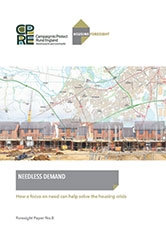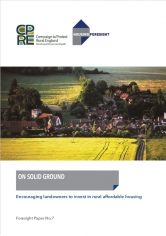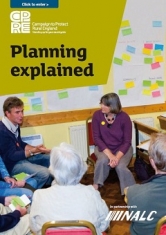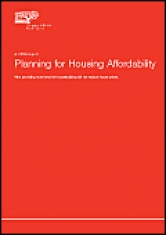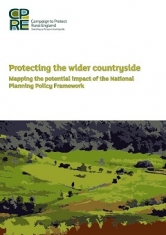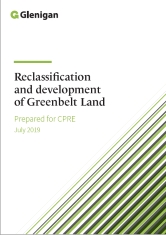Housing and planning
Needless Demand: How a focus on need can help solve the housing crisis
Needless demand: How a focus on need can help solve the housing crisis is the eighth paper in CPRE's Housing Foresight series. It analyses the current method that councils use to plan for local housing and what is being built as a result. It finds that ‘housing need’ and ‘housing demand’ are being conflated in planning policy, with the result that numbers matter more than type and tenure of housing.
Needless Demand shows how Government could split need and demand, and so tackle the housing crisis more effectively. It calls for clearer definitions of ‘need’ and ‘demand’ to be applied to planning policy, and for councils to apply them to their housing targets and local plans.
New Homes Bonus: Sharpening the incentive
Response by the Campaign to Protect Rural England (CPRE) to the Government's technical consultation
Next steps for LEPs - How greater transparency and accountability would help Local Enterprise Partnerships to support a thriving countryside.
A CPRE survey of Local Enterprise Partnerships’ approach to the environment and rural economy.
Local Enterprise Partnerships (LEPs) are business-led partnerships between the private and public sector, designed to support and promote growth in economic areas defined by local business interests and local government, and agreed with central Government.
Great concerns have been raised about the failure of LEPs to take rural and countryside issues into account, as well as their governance, transparency, and accountability.
In order to find out more about the impact on the countryside and regeneration, CPRE branches were surveyed in February and March 2017. Twelve policy recommendations for Government and LEPs are set out, based on the survey results and the best practice examples, in areas such as governance, strategic planning, and rural and countryside policy issues.
On Solid Ground
Encouraging landowners to invest in rural affordable housing
The seventh paper in CPRE's Housing Foresight series looks at the crucial role landowners can play in helping to fix the rural affordable housing crisis. The paper explores how landowners can invest in affordable housing to benefit their communities, and looks at ways in which the Government can make it easier for them do so.
Our Green Belt: worth investing in
This report summarises the key findings of 'Nature Conservation and Recreational Opportunities in the Green Belt', produced for CPRE by environmental consultants ADAS.
Plan B: How to challenge bad developments in court
A short guide to how and when you can challenge planning decisions in the courts
This guide is principally aimed at members of the public and community groups who are concerned about a proposal for development which has gained, or may gain, planning permission, and outlines the scope for legal challenge of land use planning decisions. It will help you decide whether you have a case for a judicial review or statutory challenge, and sets out how the procedure currently works following recent Government changes.
Planning explained
England’s planning system shapes new development and the use of land all over the country with the aim of achieving outcomes that are positive for people, the economy and the environment. This guide will help you to get involved in the development of your Local Plan - a key component of the planning system which will be the main influence on how your area changes in the future.
Planning for Housing Affordability
Why providing more land for housebuilding will not reduce house prices
We commissioned independent consultants Green Balance to conduct research into the relationship between planning, housing land supply and housing affordability. Our research found that increasing the supply of land for housing would make little difference to housebuilding rates or house prices. The report makes some recommendations which need to be reflected in future Government policy on housing needs.
Protecting the wider countryside
The draft National Planning Policy Framework (NPPF) proposes removing a critical policy which recognises the national importance of the countryside as a whole. This research maps these areas and shows that unless the Government revises the NPPF, more than half of the English countryside could be under greater threat from inappropriate development than before. The report recommends that the final NPPF should retain explicit recognition of the intrinsic value of the wider countryside and the character of the countryside, while favouring the efficient use of land rather than urban sprawl.
Reclassification and development of Green Belt land
Local authorities can reclassify areas as Greenbelt and also remove areas from the Green Belt.A number of local authorities have moved their Green Belt boundaries since 2010/11. This report analyses development in activity in these areas following their declassification as Greenbelt land.
The Ministry of Housing, Communities and Local Government has published polygon datasets showing each English local authority’s Green Belt land for each financial year from 2010/11 to 2017/18, with the exception of 2012/13.
These datasets have been cross-referenced with Glenigan’s construction project database to identify development activity in areas following their removal from the Green Belt.
